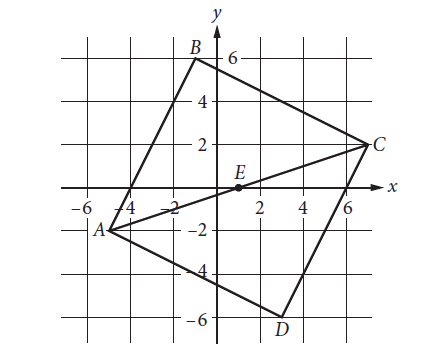
In the xy-plane above, ABCD is a square and point E is the center of the square. The coordinates of points C and E are (7, 2) and (1, 0), respectively. Which of the following is an equation of the line that passes through points B and D ?
y=−3x−1
y=−3(x−1)
y=−13x+4
y=−13x−1
Choice B is correct. In the xy-plane, the slope m of the line that passes through the points (x1,y1)and(x2,y2) is m=y2−y1x2−x1. Thus, the slope of the line through the points C(7, 2) and E(1, 0) is 2−07−1 , which simplifies to 26=13 . Therefore, diagonal AC has a slope of 13 . The other diagonal of the square is a segment of the line that passes through points B and D. The diagonals of a square are perpendicular, and so the product of the slopes of the diagonals is equal to −1. Thus, the slope of the line that passes through B and D is −3 because 13(−3)=−1. Hence, an equation of the line that passes through B and D can be written as y = −3x + b, where b is the y-intercept of the line. Since diagonal BD will pass through the center of the square, E(1, 0), the equation 0 = −3(1) + b holds. Solving this equation for b gives b = 3. Therefore, an equation of the line that passes through points B and D is y = −3x + 3, which can be rewritten as y = −3(x − 1).
Choices A, C, and D are incorrect and may result from a conceptual error or a calculation error.
Similar Questions
The inequation that best describes the following graph is _________
View SolutionThe equation of straight line shown in figure is :
ltimg src="https://d10lpgp6xz60nq.cloudfront.net/physics_images/ALN_PHY_R04_E01_020_Q01.png" width="80%"gt
View SolutionAt point P, the value of (dy)/(dx) is : ltimg src="https://d10lpgp6xz60nq.cloudfront.net/physics_images/ALN_PHY_R04_E01_025_Q01.png" width="80%"gt
View SolutionWhat is the distance OA for the square shown in figure :- ltimg src="https://d10lpgp6xz60nq.cloudfront.net/physics_images/ALN_PHY_R05_E01_015_Q01.png" width="80%"gt
View SolutionIn the chemical reactions,
ltimg src="https://d10lpgp6xz60nq.cloudfront.net/physics_images/JM_10_CHE_P1_E01_009_S01.png" width="80%"gt
the compounds 'A' and 'B' respectively are
View SolutionAt point P, the value of (dy)/(dx) is : ltimg src="https://d10lpgp6xz60nq.cloudfront.net/physics_images/ALN_PHY_R04_E01_025_Q01.png" width="80%"gt
View SolutionWhat is the distance OA for the square shown in figure :- ltimg src="https://d10lpgp6xz60nq.cloudfront.net/physics_images/ALN_PHY_R05_E01_015_Q01.png" width="80%"gt
View Solution
